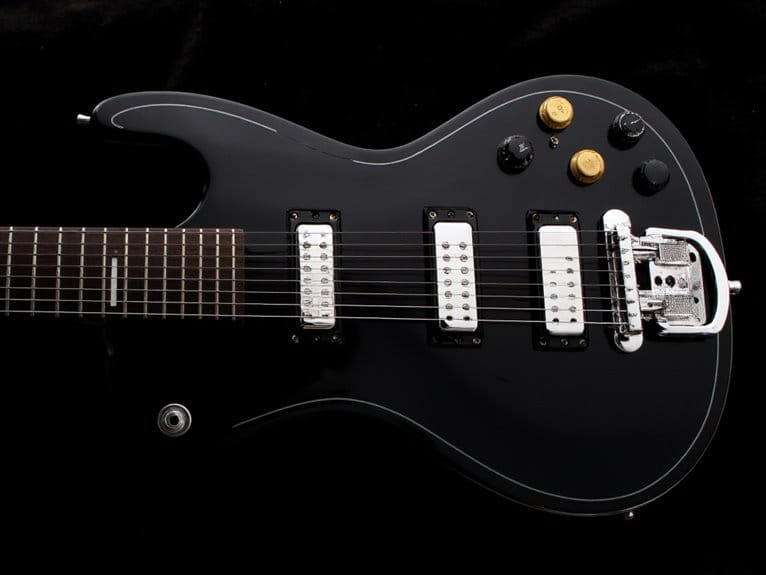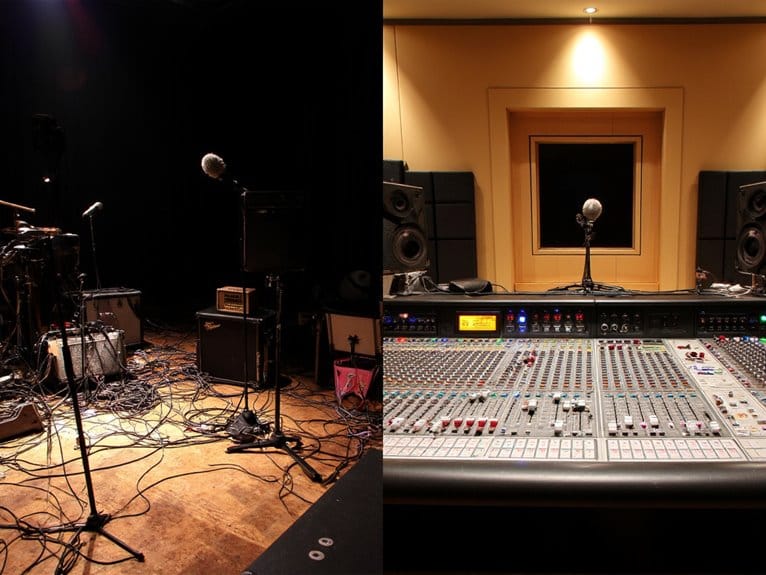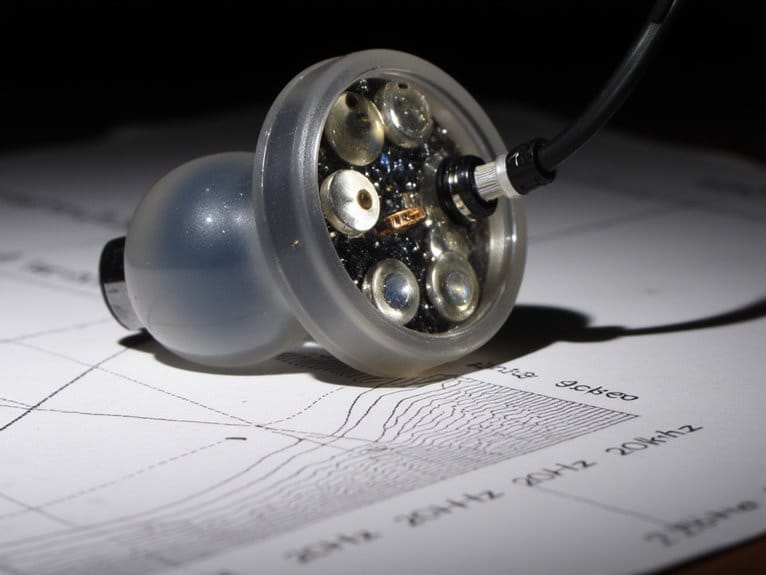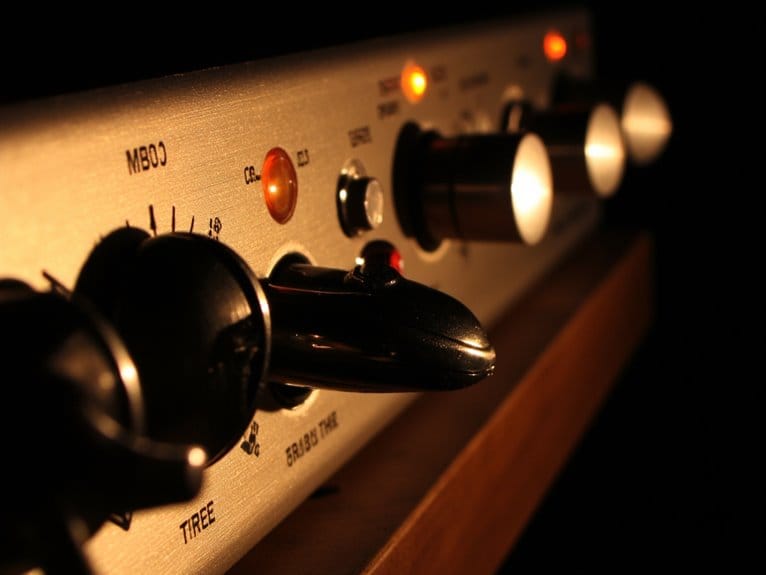Understanding Guitar Pickup Types: Single-Coil Vs Humbucker
Single-coil pickups deliver bright, crisp tones with pronounced treble response and exceptional dynamic sensitivity, making them perfect for blues, country, and funk, though they’re susceptible to 60Hz electrical hum. Humbuckers use dual-coil construction to reduce noise by 12-18dB while producing warmer, thicker sounds with enhanced midrange, ideal for rock and metal genres. Your choice depends on whether you prioritize clarity and articulation or prefer noise-free sustain and power, and exploring both types reveals deeper tonal possibilities.
We are supported by our audience. When you purchase through links on our site, we may earn an affiliate commission, at no extra cost for you. Learn more.
Notable Insights
- Single-coil pickups produce bright, crisp tones with enhanced treble response but are susceptible to 60Hz electrical hum and noise.
- Humbuckers deliver warmer, thicker sounds with reduced noise (12-18dB less low-frequency interference) through their dual-coil design that cancels hum.
- Single-coils excel in capturing playing dynamics and nuances, making them ideal for blues, country, and funk genres requiring clarity.
- Humbuckers compress signal input and provide sustained output, making them preferred for rock and metal genres needing consistent power.
- Construction differences include single-coils using one coil of copper wire around magnets, while humbuckers use two coils wired oppositely.
Basic Construction and Design Differences
When you strip away all the marketing hype and mystique surrounding guitar pickups, you’re really looking at a surprisingly simple electromagnetic device that’s remained fundamentally unchanged since the 1930s.
Guitar pickups are fundamentally simple electromagnetic devices that haven’t changed much since the 1930s despite all the marketing mystique.
At its core, pickup assembly involves three essential components: bobbin design crafted from plastic or wood, precise coil winding of thousands of copper wire turns, and strategic magnet placement beneath the coil structure. George Beauchamp’s pioneering work in the mid-1920s established the electromagnetic principles that modern pickups still rely on today.
Construction materials like polyester and fiberglass create durable bobbins, while assembly techniques using adhesives secure the framework. The coil winding process requires controlled speeds to maintain wire integrity, followed by insulation testing to verify electrical characteristics. Many builders rely on thin copper wire ranging from 42 to 43 gauge for optimal magnetic field interaction. Hand-built construction remains a hallmark of high-quality pickups, ensuring superior durability and tonal consistency.
Whether you’re examining single-coil or humbucker designs, these fundamental construction principles remain consistent across all pickup types. The choice between Alnico V and ceramic magnets significantly impacts the pickup’s tonal characteristics and dynamic response. Professional musicians understand that signal transmission quality from pickups to amplifiers relies heavily on proper cable connections and shielding to maintain the pickup’s intended tonal characteristics.
Sound Characteristics and Tonal Qualities
The moment you plug in a single-coil pickup versus a humbucker, you’ll immediately notice fundamental tonal differences that have shaped entire musical genres and playing styles for decades. Single-coils deliver bright, crisp tone articulation with pronounced treble response, while humbuckers produce warmer, thicker sounds with enhanced midrange presence. Your pickup response varies dramatically between these designs – single-coils offer superior sensitivity to picking dynamics and playing nuances, whereas humbuckers provide smoother, more consistent output. When testing these differences, keeping your volume and tone settings consistent allows you to accurately compare the inherent characteristics of each pickup type. For metal applications, active pickups maintain clarity and aggressive punch through built-in preamps, while passive pickups present warmer tones overall. Professional audio engineers often utilize digital mixers with multiple input channels to capture the full tonal spectrum and subtle characteristics of different pickup configurations during recording sessions. The split-coil designs found in many bass guitars effectively reduce electrical hum while maintaining the tonal clarity that intermediate players seek.
| Characteristic | Single-Coil | Humbucker |
|---|---|---|
| Brightness | Bright, chimey | Dark, warm |
| Distortion Handling | Clean clarity | High-gain friendly |
| Midrange | Upper-mid focus | Rich, thick mids |
| Dynamic Response | Highly sensitive | Smooth, even |
| Genre Suitability | Blues, country, funk | Rock, metal, jazz |
Noise and Interference Performance
While tonal qualities might grab your attention first, noise performance often determines whether you’ll actually enjoy playing your guitar in real-world situations. Humbuckers excel here, delivering 12-18dB less low-frequency pickup noise than single coils through their dual-coil, hum-cancelling design that eliminates electromagnetic interference.
Single coils, despite their appealing brightness, pick up ambient electrical noise from lighting and amplifiers, creating that characteristic 60Hz hum you’ve probably noticed.
Shielding effectiveness varies greatly between approaches—grounded foil reduces noise by 6-12dB, while strategic steel shielding adds another 12dB reduction. Active pickups present an interesting tradeoff: they minimize electromagnetic interference but introduce slight hiss from their preamp circuits.
Your playing environment matters too; studio work might favor humbuckers’ quiet operation, while single coils’ natural noise can actually enhance certain musical styles. When recording, maintaining a signal-to-noise ratio above 70 dB helps ensure professional-quality guitar tracks without unwanted background interference. High-quality piezo pickup systems are essential for capturing tonal nuances while maintaining professional-grade sound output across different playing conditions. For recording applications where maintaining signal clarity is critical, many guitarists utilize bass preamps with noise gates that can achieve -120dB EIN noise floors to further eliminate unwanted background interference.
Historical Development and Evolution
You’ll find that electric guitar pickups didn’t just appear overnight, but evolved through decades of innovation starting with George Beauchamp’s horseshoe pickup in 1937 and the early Rickenbacker “Frying Pan” models.
I’ve watched how the persistent 60-cycle hum problem in single-coil designs pushed Gibson engineers like Seth Lover to create the revolutionary humbucker in 1955, which fundamentally changed what guitarists could achieve sonically.
As different musical genres emerged through the 1960s, you’d see musicians gravitating toward specific pickup types that matched their sound, with blues and country players often preferring bright single-coils while rock and jazz artists embraced the thicker, warmer humbucker tone. Today’s H-H pickup configuration delivers rich tones that are particularly ideal for rock music while offering superior noise-canceling properties compared to traditional single-coil setups.
Modern single-coil innovations now feature wax-potted designs and reverse-wound configurations that effectively address the traditional hum issues while maintaining the characteristic crystal clear tone that made them legendary. Budget-conscious guitarists can now find quality instruments under $300 that feature versatile pickup configurations including S-S-S, HSS, and H-H setups that enable diverse tonal options across various musical genres.
Early Electric Guitar Origins
Before we explore the intricate world of pickup magnets and coil windings, I need to take you back to the late 1800s when inventors first imagined amplifying guitar sound electrically.
The electric guitar timeline begins with George Breed’s 1890 patent, though his heavy, unusual instrument didn’t exactly spark a revolution. Real progress emerged through significant innovations like Lee Forest’s 1907 triode vacuum tube, which made amplification possible, and the 1921 paper-cone loudspeaker that improved sound delivery.
You’ll find the breakthrough moment in 1931 when George Beauchamp and Paul Barth developed the horseshoe pickup for Electro-String, leading to 1932’s Ro-Pat-In “Frying Pan”—the first commercially successful electric guitar that actually caught musicians’ attention.
Humbucker Innovation Response
As electric guitars gained popularity through the 1940s and early 1950s, the persistent electromagnetic hum from single-coil pickups became an increasingly frustrating problem that demanded a technical solution. You’ll find that buckers evolution actually began much earlier than most people realize, with Armand Knoblaugh’s 1935 patent and Arnold Lesti’s twin-coil design laying vital groundwork. Seth Lover’s breakthrough at Gibson around 1954 perfected the concept, creating the PAF humbucker that launched commercially in 1957.
| Innovation Period | Key Development |
|---|---|
| 1934-1939 | Early hum-canceling concepts |
| 1954-1955 | Lover’s refined design |
| 1957 | Commercial PAF release |
| Post-1957 | Design innovations spread |
These design innovations transformed guitar electronics forever, allowing you to achieve higher gain levels with dramatically reduced noise interference. The development of wax potting techniques became essential for eliminating microphonic feedback, particularly crucial in high-gain applications that humbuckers made possible. Modern manufacturers like Ibanez now offer various pickup configurations including H-S-S and H-H setups that provide guitarists with exceptional genre flexibility and tonal versatility. The Squier Affinity Series Telecaster maintains the traditional single-coil pickups that defined the classic Telecaster sound for decades.
Genre-Specific Pickup Adoption
The revolutionary humbucker technology that solved electromagnetic interference opened new sonic territories, but it’s the way different music genres embraced specific pickup types that really shaped guitar’s role in popular music.
Country and blues artists stuck with single coil advantages, prizing their bright, articulate twang that cut through mix cleanly. Jazz musicians developed humbucker preferences for their warm, noise-free sustain during complex chord progressions.
Rock guitarists gravitated toward humbuckers’ ability to handle distortion without feedback, while funk players demanded single-coils’ percussive snap. Modern guitarists now benefit from HSS pickup configurations that combine both humbucker warmth and single-coil clarity through versatile switching systems.
This tonal flexibility drove genre evolution throughout the ’60s and ’70s, with surf rock popularizing Stratocaster brightness and hard rock cementing Les Paul’s thick growl as essential sounds in music history. Bass players in rock also benefit from dual humbucking pickups that deliver the aggressive tonal versatility and excellent noise rejection crucial for heavier styles. The vintage warmth of Alnico magnets became particularly coveted during this era, offering the smooth response curves that defined classic rock tones.
Musical Genre Applications
When I consider how different musical genres shape pickup selection, I’m struck by how dramatically tonal requirements can vary between styles.
Rock and metal guitarists gravitate toward humbuckers for their powerful output and noise rejection, while blues and jazz players often embrace the bright, articulate qualities of single-coils that cut through dense mixes with remarkable clarity.
Humbuckers deliver the crushing power metal demands, while single-coils provide the crystalline articulation that defines blues and jazz tones.
This pickup versatility becomes even more apparent when examining how genre influences dictate specific tonal needs.
Country players prize the twangy bite of single-coils, funk musicians rely on their crisp attack for percussive rhythms, and fusion artists often switch between both types mid-performance.
I’ve noticed that modern experimental genres push boundaries further, incorporating active pickups and even optical systems to achieve previously impossible sonic textures.
Metal players particularly benefit from humbuckers paired with nickel-plated steel strings, which deliver the balanced brightness and sustain needed for aggressive downtuned compositions.
Bass players often utilize PJ configurations that combine precision and jazz pickups, allowing them to adapt seamlessly between the classic punchy P-bass thump and the brighter articulation needed for complex musical arrangements.
Playing Style Considerations
Your playing style profoundly influences which pickup type will complement your technique, as single coils respond differently to dynamic touch and volume changes compared to humbuckers‘ more compressed, sustained output.
When you’re executing intricate fingerpicking patterns or rapid single-note runs, single coils provide the articulation and note separation that makes each phrase crystal clear, while humbuckers excel when you need sustained leads with smooth volume swells and expressive bends.
The choice becomes even more critical when you consider how different genres demand specific dynamic responses, from the crisp attack needed for country chicken picking to the thick sustain required for metal power chords.
Dynamic Response Differences
Although I’ve spent countless hours analyzing pickup specifications over the years, I’m convinced that dynamic response represents one of the most overlooked yet essential factors in how pickups interact with your playing style, fundamentally shaping whether your subtle touch variations translate into expressive musical nuances or get lost in electronic compression.
Here’s how different pickups handle your playing dynamics:
- Single coils deliver superior dynamic range – translating every soft touch and aggressive attack into faithful amplified sound
- Humbuckers compress your input signal – smoothing out extremes while reducing touch sensitivity for consistent output
- Output levels directly affect dynamics – higher humbucker outputs saturate amps earlier, compressing your natural playing variations
- Physical design influences responsiveness – single-coil simplicity provides immediate string response compared to dual-coil inductance delays
Genre-Specific Pickup Applications
Dynamic response capabilities naturally lead us to examine how different pickup types align with specific musical genres and playing approaches, since your touch sensitivity needs will vary dramatically depending on whether you’re laying down clean country licks or driving through high-gain metal riffs.
Single-coils excel in blues, country, and funk where brightness and articulation matter most, though their noise susceptibility limits high-gain applications.
Humbuckers dominate rock and metal genres, delivering thick, warm tones with essential noise reduction for heavy distortion.
P90s occupy the middle ground, offering gritty character perfect for punk and classic rock.
Genre compatibility often determines pickup choice more than personal preference.
Filter-Tron variants provide pickup versatility for rockabilly and indie styles, balancing clarity with reduced hum, making them increasingly popular among players seeking unique tonal signatures.
Choosing the Right Pickup for Your Needs
How do you navigate the seemingly endless world of guitar pickups when each type promises to transform your sound? Your playing style and musical preferences should guide your decision, though I’ve learned that understanding your needs beats chasing trends every time.
Consider these key factors when selecting pickups:
- Genre requirements – Single-coils excel in country, blues, and funk, while humbuckers dominate rock, metal, and jazz applications.
- Noise tolerance – Performance venues with electrical interference favor humbuckers’ quiet operation over single-coil clarity.
- Output matching – Higher-gain styles benefit from humbucker output levels, whereas clean tones shine with single-coil articulation.
- Future flexibility – Mixed pickup configurations and upgrade options provide versatility as your musical journey evolves.
Frequently Asked Questions
Can I Replace Single-Coil Pickups With Humbuckers on My Existing Guitar?
You can replace single-coils with humbuckers, but pickup compatibility requires routing larger cavities and wiring considerations include different electronics schemes. You’ll likely need professional installation due to physical modifications and rewiring complexity.
How Much Does Pickup Height Adjustment Affect Tone and Output?
Pickup height greatly affects your guitar’s tone adjustment and output level. Raising pickups closer increases volume and brightness but risks magnetic pull on strings. Lowering them produces cleaner, more natural dynamics with reduced output.
Do Active Pickups Work Better Than Passive for Metal Music?
Active vs passive pickups both work well for metal genre, but you’ll get tighter low-end, higher output, and less noise with actives. However, you might prefer passive pickups if you want more organic dynamics.
What’s the Difference Between Ceramic and Alnico Pickup Magnets?
Ceramic advantages include stronger magnetic fields producing higher output and brighter, more aggressive tones perfect for metal. Alnico characteristics offer weaker fields creating warmer, vintage sounds with smoother mids you’ll love for blues and classic rock.
Can Coil-Splitting Humbuckers Truly Replicate Authentic Single-Coil Sound?
Your coil splitting options won’t perfectly replicate authentic tone from true single-coils. You’ll get usable sounds that’re close, but they lack the full brightness, dynamics, and tonal complexity of genuine single-coil pickups.
On a final note
You’ve now got the knowledge to make an informed pickup choice, and honestly, there’s no universal “best” option since your playing style, genre preferences, and tonal goals will ultimately determine what works for you. Whether you’re drawn to the bright clarity of single-coils or the robust power of humbuckers, remember that great tone comes from understanding how your pickup interacts with your amp, effects, and most importantly, your hands.





